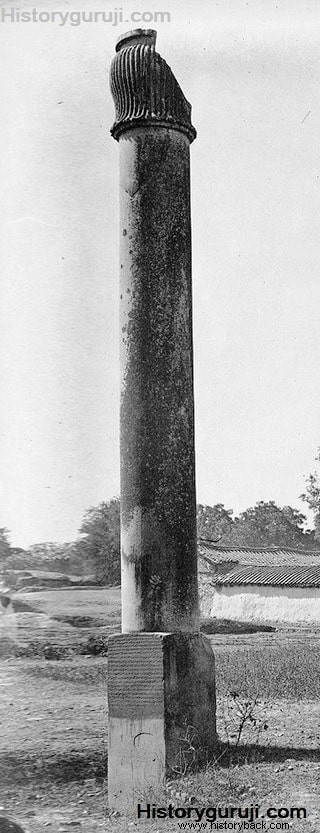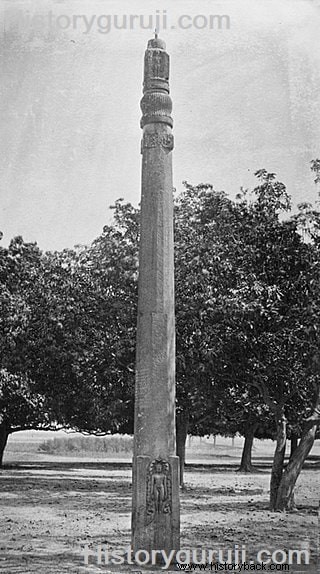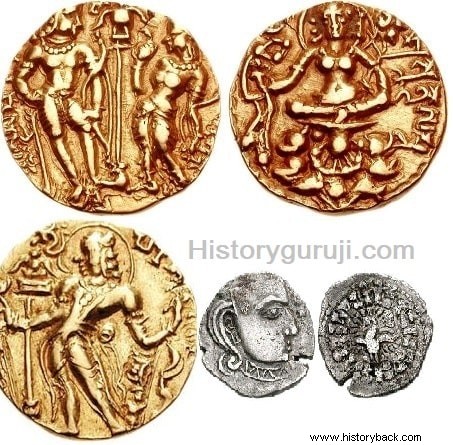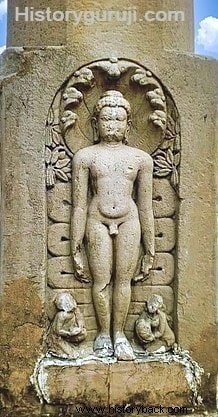Samudragupta 'Mighty Number'
After the death of Kumaragupta, the Gupta rule was succeeded by his able son Skandagupta. In the Junagadh inscription, the first date of his rule is found inscribed in Gupta Samvat 136 (455 AD). In Garhwa inscriptions and silver coins, his last date is found in Gupta Samvat 148 (467 AD). Thus it is clear that Skandagupta ruled from 455 to 467 AD (about twelve years). Skandagupta's reign was a period of great upheaval in terms of political events.
Historical Sources
Many inscriptions from the reign of Skandagupta have been found, which throw light on the events of his reign.
Junagarh Commendation: The Junagadh Prashasti received from Saurashtra (Gujarat) is the most important of the Skandagupta inscriptions. In this, the first date of his reign is inscribed in the Gupta era 136 (455 AD). It is known from the prashasti that Skandagupta had defeated the Hunas and appointed Parnadatta as his governor (Gopta) in the province of Surashtra. His Purpati Chakrapalit (son of Parnadatta) of Girnar city got the Sudarshan lake rebuilt. This citation shows that at that time the time-calculation was done in the Gupta era (Guptaprakale calculation method).

inner column: This article has been obtained from a place called Bhitri in Saidpur tehsil of Ghazipur district (Uttar Pradesh). It describes the war of Skandagupta with Pushyamitra and Hunas.
Supia column-text: The Supia inscription of Gupta era 141 (460 AD) has been received from a place called Supiya in Rewa district (Madhya Pradesh). In this article, the Gupta dynasty starts from the time of Ghatotkach and the Gupta dynasty is called 'Ghatotkachvansh ’ has been said.
kaum (where) column-text: This article has been found from a place called Kahoum in Deoria (Uttar Pradesh). In this the date of Gupta Samvat 141 (460 AD) is mentioned. In this article Skandagupta is called 'Shakropan ' Having said. It is known from the article that a person named Madra got the statues of five Jain Tirthankaras constructed.

Indore Chalcohol: A copper inscription of Gupta Samvat 146 (465 AD) has come to light from a place called Indore of Bulandshahr (U.P.), in which the description of donating money for worshiping the Sun and lighting a lamp in the Sun temple is found.
Bihar column-text: A dateless inscription has been found from a place called Bihar near Patna (Bihar State), in which the names of Gupta rulers and some officials till the time of Skandagupta are found.
Garhwa Inscription: The last inscription of Skandagupta's reign has been found from a place called Garhwa located in Karchana of Allahabad (U.P.), in which Gupta era 148 (467 AD) is inscribed. From this it seems that he ruled till at least 467 AD.
currencies: Some gold and silver coins of Skandagupta have been found. The figure of a king with bow and arrow on the face of his golden postures and Lakshmi seated in Padmasana on the reverse side 'Sriskandagupta ' is engraved. Garudadhwaja and its title 'Kramaditya' are found on some mudras. Silver currencies remain the same as before. On the face there is a picture of the king up to the chest and on the back part there is the marking of Garuda, Nandi or the altar.
Chandragupta II 'Vikramaditya'
Succession War
The name of Kumaragupta's wife was Mahadevi Anantadevi, whose son was Purugupta. Skandagupta's mother was probably not Patrani or Mahadevi. Rameshchandra Majumdar estimates that Purugupta became the ruler of the Gupta dynasty after the death of Kumaragupta. Skandagupta defeated Purugupta in this succession battle for the throne and took control of the Gupta kingdom. A verse from Skandagupta's inner pillar-inscription also reveals that Rajalakshmi of the Gupta dynasty had become fickle, which Skandagupta distinguished with her muscle power. He went to his mother Devaki after destroying the enemy in the same way as Krishna went to his mother Devaki after destroying the enemies-
Pitiri Divmupate Wiltata Vanshalakshmi BhujbalVijitariyah Pratishthaya Bhuyaha.
Jitmiva Paritoshan Mataram Sasrunetran, Hatripuriva Krishna Devakimbhupetah.
The Junagadh article reveals that Lakshmi herself had chosen her by abandoning all the princes (Vyapetya Sarvan Manujendraputran Lakshmi herself as Varyanchaka r). This scene is also depicted on the gold coins of the Lakshmi type of Skandagupta, whose face has a picture of Lakshmi on the right and the king on the left. Lakshmi is depicted offering something to the king.
But these mentions do not suggest that Skandagupta had to face any civil war. It is clear from the Bhitri inscription that during the reign of her father the rebellion of Pushyamitra had taken such a fierce form that Kullakshmi of the Gupta period was distraught and Skandagupta had to spend many nights sleeping on the ground to restore her. Just as Krishna defeated his enemies and went to his mother Devaki, in the same way Skandagupta also went to his mother after destroying the enemy class and tears came to his mother's eyes. Rajyashree himself had selected Skandagupta in a permanent form. In this way, Skandagupta had shown his extraordinary talent and valor by defeating Pushyamitra.
Probably being the eldest son, Purugupta had the right on the throne, but due to power and valor, Rajyashree himself came to Skandagupta. Aryamanjushrimoolakalpa also shows that after Kumaragupta, Skandagupta was sitting on the throne of the Gupta Empire-
Samudrakhya Nripishchaiva, Vikramashchaiva Kirtitha.
Mahendranrupavarou Mainah, Sakaradyam Anthyapuram.
It is clear that here Samudra, Vikram, Mahendra and Sakaradya are used for Samudragupta, Chandragupta Vikramaditya, Kumaragupta and Skandagupta respectively.
Samudragupta 'Parakramnk'
Achievements of Skandagupta
Defeat of the Huns
The most important event of the reign of Skandagupta was the defeat of the barbaric Hunas. The Huns were a nomadic barbarian race living in Central Asia. Due to his attacks, the Yu-chi people were forced to leave their ancient place of residence and move towards Shakasthan. After being driven out by the Yuchis, the skeptics moved towards Iran and India. It was as a result of the Huns' invasions that the Shakas and Yu-Chi peoples entered India. In course of time, the Huns had two branches - the western branch and the eastern branch. The Huns of the western branch attacked in the far west and shattered the Roman Empire. Due to the atrocities and barbarism of the Hun king Attila, the whole western world was in turmoil. The White Huns of the eastern branch crossed the Hindukush Mountains and first captured Gandhara and then began to challenge the Gupta Empire.
The first invasion of the Huns occurred during the time of Skandagupta whose leader was probably Khushnavaj. Protecting the Gupta-kingdom by successfully resisting the Hun invasion is the biggest event of Skandagupta's reign.
According to the Bhitri pillar-inscription, Skandagupta had such a fierce encounter with the Huns that the whole earth shook (Hunairyasya Samagatasya Samare Dorbhyam Dhara Kampita. Bhimavart Karsya , But in the end Skandagupta was victorious and because of his victory, his good deeds started being sung all over India till Kumari Anteep. Buddhist texts Chandragarbha-pariprchha According to this, in this war with the Huns, the number of soldiers in the Gupta army was two lakhs and the army of the Huns was three lakhs. Even then the Gupta army was victorious in the face of the fierce and barbaric Huns. Grammar of Chandragomin There is also a source that the Guptas defeated the Hunas (Ajayat Jarto Hunan ) which indicates the Huna conquest of Skandagupta.
Somdev Ke Kathasaritsagar It also shows that Vikramaditya, the son of King Mahendraditya of Ujjayini, defeated the Mlechchas-
Ujjayinyan Sutha Shuro Mahendradityabhupateh.
praveeram bhootale yastanmallechhanutsadayyyyati.
It is thus clear that the Hunas were badly defeated during the time of Skandagupta and could not advance beyond Gandhara. The splendor of the Gupta Empire remained almost intact during the reign of Skandagupta.
battleground: The place where Skandagupta fought with the Huns is not clear. Mentioned in the Bhitari article 'Shrotrashu Gangadhwanih' Based on V.P. Sinha speculates that this war was fought somewhere in the Ganges valley, but this word cannot be taken as indicative of the battlefield. According to the Atrei belief, the war between Skandagupta and the Hunas must have taken place on the north-western frontier of the Gupta Empire.
Upendra Thakur is of the view that the Hun war was fought either on the banks of the river Sutlej or in the plains of western India. The Junagadh inscription shows that Skandagupta was concerned about the border of the western region and only after extensive deliberation had appointed qualified Parnadatta as the protector of this region.
Thus it seems more logical to consider any part of western India as a battlefield. Wherever the war took place, it is certain that Skandagupta defeated the Hunas and saved the Gupta Empire from a terrible crisis. Due to this heroic act he became 'Vikramaditya like Samudragupta and Chandragupta II. He was entitled to bear the title of '. Skandagupta must have defeated the Huns before 460 AD as it is known from the Kahoum inscription of this date that there was peace in his kingdom. The later Indore and Garhwa writings also give information about peace and prosperity in his empire. Thus the Hun invasion must have taken place in the early years of his rule.
Gupta Administration and Economic Life
Skandagupta faced great economic crisis due to the invasion of the Huns, which is evident from his coins. Its number of gold coins is less and the amount of adulteration in them is also high.
defend the empire from the Vakatakas
The Mandsaur inscription shows that taking advantage of the initial difficulties of Skandagupta, the Vakataka ruler Narendrasen captured Malwa. The Vakataka king Narendrasen has been described as the ruler of Kosala, Mekal and Malwa in the Balaghat article (Kosal Mekal Malvadhipati:Abhyarchitshasana: , But Skandagupta defeated the Vakataka ruler and strengthened his authority over this region.
Vakataka Dynasty
Destruction of the serpent
The Junagadh inscription states that Skandagupta's Garudadhwaj-inscribed Rajagya Nagarupi was the one who killed the kings who took their hoods with pride and pride-
Narapati Bhujanganam Mandarpotfannam.
Replica Garudagyna Impulsive Walker.
On this basis historians like Fleet speculate that Skandagupta defeated the Nagavanshi kings. But it is impossible to say anything with certainty in this regard.
The revival of the revolutionary movement:Bhagat Singh and Chandrashekhar Azad
Suppression of Rebellions
Some historians consider that Govindagupta was the younger uncle of Skandagupta, who was appointed as the governor of Malwa. He revolted against Skandagupta and Skandagupta successfully suppressed this rebellion.
Empire Expansion and Administration of Skandagupta
Although Skandagupta did not expand the Gupta Empire by conquering any new territories, the wide circulation of inscriptions and coins suggest that the Gupta Empire remained completely intact until his reign. In fact, it is last to rule over a vast area from the Himalayas in the north to the Narmada River in the south and from Bengal in the east to Saurashtra in the west. 'Asamudrakshitish ' was the Gupta emperor.
Skandagupta was a great conqueror as well as an able administrator. Records reveal that his vast empire was divided into provinces.
province to country, avni or subject was called Provincial Rulers to be 'Gopta ' It was called. The Gopta of the Surashtra province was Parnadatta, who was appointed after a lot of thought. The ruler of Antarvedi (the doab of Ganga-Yamuna) was Sarvanag. Bhimavarman was the governor of Kosambi, whose mention is found in a stone-statue found from there. Town chiefs were appointed in major cities. The city administrator of Girnar was Chakrapalit, son of Parnadatta.

Currencies: स्कंदगुप्त के समय के सोने की मुद्राएँ कम पाई गई हैं। जो सुवर्ण मुद्राएँ मिली हैं, उनमें भी आरंभिक गुप्त मुद्राओं की अपेक्षा सोने की मात्रा कम है। इससे लगता है कि हूणों के साथ युद्धों के कारण गुप्त साम्राज्य की अर्थव्यवस्था अस्त-व्यस्त हो गई थी।
धर्म और धार्मिक नीति (Religion and Religious Policy of Skandagupta)
स्कंदगुप्त धर्मनिष्ठ वैष्णव था और उसकी उपाधि ‘परमभागवत’ थी। उसने भितरी में भगवान् विष्णु की प्रतिमा स्थापित करवाई थी। पर्णदत्त के पुत्र तथा गिरनार के नगरप्रमुख चक्रपालित ने सुदर्शन झील के तट पर विष्णु भगवान के एक मंदिर का निर्माण करवाया था। स्कंदगुप्त की उदार धार्मिक नीति के कारण अन्य अनेक धर्म भी स्वाभाविक रूप से विकसित हो रहे थे। इंदौर लेख में सूर्यपूजा का उल्लेख मिलता है। कहौम लेख से पता चलता है कि मद्र नामक व्यक्ति ने पाँच जैन तीर्थंकरों की पाषाण-प्रतिमाओं का निर्माण करवाया था, जो उस क्षेत्र में जैन परंपरा की लोकप्रियता का प्रमाण है।
त्रिपुरी संकट :सुभाष बनाम गांधी

लोकोपकारिता के कार्य
स्कंदगुप्त उदार, दयालु और प्रजावत्सल सम्राट था। उसके शासनकाल में प्रजा पूर्णरूपेण सुखी और समृद्ध थी। इस लोकोपकारी शासक को अपनी प्रजा के सुख-दुःख की चिंता निरंतर बनी रहती थी। जूनागढ़ अभिलेख से पता चलता है कि उसके शासनकाल में भारी वर्षा के कारण सुदर्शन झील का बाँध टूट गया था, जिससे प्रजा को बड़ा कष्ट हो रहा था। स्कंदगुप्त के आदेश से सौराष्ट्र (काठियावाड़) के प्रांतीय शासक पर्णदत्त ने दो माह में अतुल धन व्यय करके पत्थरों की जड़ाई द्वारा उस झील के बाँध का पुनर्निर्माण करवा दिया।
प्रसंगतः, सुदर्शन झील का निर्माण सम्राट चंद्रगुप्त मौर्य के शासनकाल में सुराष्ट्र के प्रांतपति वैश्य पुष्यगुप्त ने पेयजल और सिंचाई की सुविधा के लिए करवाया था। बाद में अशोक के समय में प्रांतीय शासक यवन तुषास्प ने इस झील पर एक बाँध का निर्माण करवा दिया था। यह बांध पहली बार शक-महाक्षत्रप रुद्रदामन् (130-150 ई.) के समय में टूट गया था जिसका पुनर्निर्माण उसने अत्यधिक धन व्यय करके अपने राज्यपाल सुविशाख द्वारा करवाया था।
सविनय अवज्ञा आंदोलन और गांधीजी
स्कंदगुप्त महान् विजेता और कुशल प्रशासक था जिसने अपनी वीरता और पराक्रम के बल पर अपने वंश की विचलित राजलक्ष्मी को पुनःप्रतिष्ठित किया। उसकी योग्यता और बुद्धिमत्ता के कारण ही सभी राजकुमारों को छोड़कर लक्ष्मी ने स्वयं उसका वरण किया था (व्यपेत्य सर्वान् मनुजेंद्रपुत्रान् लक्ष्मी स्वयं यं वरयांचकार , युवराजकाल में ही उसने पुष्यमित्र जैसी भयंकर जाति को पराजित किया और सम्राट बनने पर बर्बर हूणों का मान-मर्दन कर भारत-भूमि की रक्षा की। गुप्तवंश के इस अद्वितीय वीर (गुप्तवंशैक वीरः ) की अमल कीर्ति का गान बालक से लेकर प्रौढ़ तक प्रसन्नतापूर्वक सभी दिशाओं में करते थे (चरितयममलकीत्तैः गीयते यस्य शुभ्रं दिशि-दिशि परितुष्टैराकुमारैः मनुष्यैः , बौद्ध ग्रंथ आर्यमंजुश्रीमूलकल्प में भी स्कंदगुप्त को श्रेष्ठ, बुद्धिमान् तथा धर्मवत्सल सम्राट कहा गया है।
जूनागढ़ लेख में कहा गया है कि जिस समय वह शासन कर रहा था, उसकी प्रजा में कोई ऐसा व्यक्ति नहीं था जो धर्मच्युत् हो, दुःखी हो, दरिद्र हो, आपत्तिग्रस्त हो, लोभी हो या दंडनीय होने के कारण अत्यंत सताया गया हो-
तस्मिन्नृपे शासति नैव कश्चिद्, धर्मादपेतो मनुजः प्रजासु।
आत्तो दरिद्रो व्यसनी कदर्य्यो दंड्यौ न वा यो भृशपीड़ितः स्यात्।।
गुप्तवंश के महान् शासकों की शृंखला में स्कंदगुप्त अंतिम था। 467 ई. में उसकी मृत्यु के बाद गुप्त साम्राज्य में विघटन और विभाजन की विविध प्रवृत्तियाँ क्रियाशील हो गईं। धीरे-धीरे गुप्तवंश के ध्वंसावशेषों पर अनेक नये राज्य अपनी स्वतंत्र सत्ता स्थापित करने लगे और अंततः 550 ई. में गुप्त साम्राज्य का पतन हो गया।
भारत में ‘सती’ की अवधारणा
प्राक्-गुप्त युग में भारत की राजनैतिक दशा
उन्नीसवीं सदी में भारतीय पुनर्जागरण
आजाद हिंद फौज और सुभाषचंद्र बोस
देसी रियासतों में भारतीय राष्ट्रीय आंदोलन
ब्रिटिश भारत में दलित-आंदोलन
चंद्रगुप्त मौर्य की शासन-व्यवस्था
बाबर के आक्रमण के समय भारत की राजनैतिक दशा
India in 6th century BCE:Sixteen Mahajanapadas
1857 की क्रांति :कारण और प्रसार
रूस का आधुनिकीकरण:पीटर महान और कैथरीन द्वितीय
